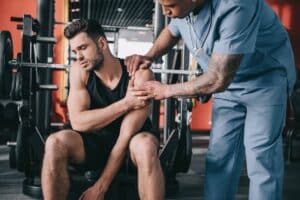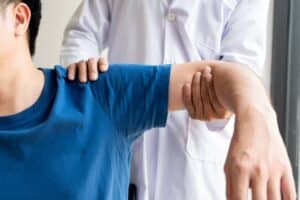
Sometimes you need to learn how serious your neglected shoulder injury can get before you need professional help. How would I know when to see a doctor for my shoulder injury? What doctor do you see for shoulder pain?
Some shoulder pain can be ignored and will get better on its own over some time. It can work for most people but might be bad for serious shoulder and elbow injuries.
Shoulder injuries are prevalent, particularly in athletes who use repetitive motions in their sport, like tennis players, swimmers, pitchers, and weightlifters. While common in athletes, injuries can happen during day-to-day activities too.

A countless number of individuals live with shoulder pain every day. If you're one of those people experiencing weakness or have difficulty lifting above shoulder level, here is everything you need to know.
How can you tell if you need to be seen by a shoulder pain doctor? Here are the top signs that should be seen by a shoulder pain doctor.
After an intense fall, there might be a popping sound in your shoulder, followed by severe pain or weakness. This may be a tear in your rotator cuff or an AC joint separation. Once you hear the popping sound after a fall, you must see a doctor immediately before your injury worsens.
Shoulder weakness after getting injured may be due to a ruptured or torn rotator cuff. This is usually caused by a sudden force being exerted on the shoulder. Large tears on the rotator cuff usually cause weakness, especially when lifting your arm. If you are experiencing this, it's time for you to see a doctor.
If you lack stability in your shoulder after getting injured, it means that your shoulder is most likely dislocated. Sometimes, a dislocated shoulder will return to its place immediately after getting up from the ground. Some will not – this is when you need to be seen by an orthopedic doctor.
You may notice a bump on the top part of your shoulder after a sudden fall. A bump always comes with severe pain, indicating an injury in your AC joint or a shoulder separation. Most AC separation cases do not require surgery, but a doctor's evaluation is necessary to assess your AC separation type. Once the doctor determines which type of AC separation you have, you will know if your shoulder injury is serious or needs time to recover.

A sudden fall onto your shoulder transmits the force to your clavicle (collarbone), which can make it fractured. After the injury, you may notice a bump over your clavicle and severe pain in that area. It is important to have a doctor evaluate your type of fracture so you can receive proper care before the injury worsens.
Most shoulder injuries can worsen when left untreated. That is why it is important to immediately see an
Shoulder tendinitis typically stems from a repetitive motion. Occasionally, a more unexpected injury can cause the problem. It's common in athletes, especially those who may inadvertently use the incorrect form, putting additional stress on the tendons and tissues in the shoulder.
Shoulder tendinitis treatment focuses on regaining mobility and reducing the discomfort caused by swelling and pain. Rest and ice on the shoulder is an amazing start — it will help lessen the swelling. Physical therapy can help ease the symptoms and regain strength in the shoulder. Surgery is often only needed if the tendon has been partially or wholly torn.
Shoulder bursitis occurs when the small fluid-filled sacs (bursae) that protect and cushion bones, tendons, and muscles become inflamed. The shoulder is among the most common locations for bursitis, often in joints that perform repetitive motions.
Bursitis can lead to stiffness and swelling in addition to general pain in the shoulder. It might be an inconvenience when you apply or move pressure to the shoulder. Generally, bursitis will subside due to rest and extra care to protect the joint and limit use. If pain persists, you should see a doctor to develop a practical course of treatment. Your doctor might suggest medication to reduce inflammation, therapy to strengthen your muscles in the shoulder, injections to lessen more severe inflammation, or surgery. Surgery is seldom needed in the treatment of bursitis.
Rotator cuff tears are common, particularly in people who are middle-aged or conduct repetitive overhead motions at work or while playing a sport. Tears can occur over time due to wear and tear or a sudden accident or injury.

Most individuals describe the pain from a rotator cuff tear as a dull pain that worsens once you sleep on the affected shoulder.
The tear can make it hard to reach behind your back to do everyday tasks like brushing your hair. It might also make your arm feel weak. Rotator cuff tears are common in people:
If you think you have a rotator cuff tear or other severe shoulder injuries, it's advised that you book an appointment to see an orthopedic doctor. There are many options for treatment, but they're typically more effective if the injury is diagnosed early.
Your doctor might recommend physical therapy to improve the strength of your shoulder. Injections are an alternative to help reduce the pain, although it's crucial to remember that even though the pain might be gone, the underlying issue isn't. Surgery can help repair your tendon and, if necessary, replace your shoulder joint.
Shoulder instability happens once the (upper arm bone) humerus is forced out of your shoulder socket. Sometimes this results from overuse, while in some cases result from sudden injury or accident. Unfortunately, once a shoulder has dislocated, it is likely to occur again — when the shoulder repeatedly dislocates, it is known as chronic shoulder instability.
Physical therapy and modifications to the activities can help minimize the symptoms. Moreover, physical therapy can help strengthen the shoulder to improve stability. Anti-inflammatory medications and injections can also help to relieve the swelling and pain. Surgery is sometimes needed to repair damaged ligaments, letting them hold the shoulder in place again.
The labrum keeps the humerus (upper arm) ball joint in place — a rubber tissue attached to your shoulder socket to help keep your joint stable. A superior labrum, anterior to posterior lesion (SLAP), is a tear above the middle of your shoulder socket. Tears to the labrum can happen from an unexpected injury or can wear and tear as we get old.

Injuries resulting in a labrum tear include falling on the arm or shoulder, a direct hit to your shoulder, reaching overhead rapidly, or an unexpected pull. Some athletes, such as weightlifters or throwing athletes, can see these injuries due to a repetitive motion that wears down your labrum.
Physical therapy might help strengthen the muscles in your rotator cuff, while anti-inflammatory medications can help alleviate the symptoms. Surgery may be necessary if there's no improvement with more conservative treatments. For a tear in the labrum, surgery is minimally invasive. While therapy is always necessary after surgery to regain your range of motion and strength, there's minimal downtime.
If you are in pain from a serious shoulder injury, orthopedic doctors are your best bet. These doctors can help examine your injury and provide the best treatment options that can help you get back to your 100%.
If you need reliable orthopedic doctors for your shoulder pain, please reach out to us today!